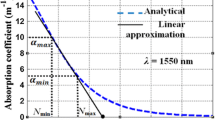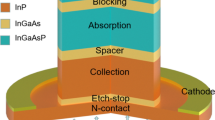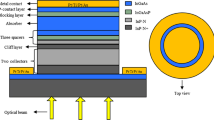Abstract
A small signal equivalent circuit model of uni-traveling carrier photodiode (UTC-PD) is developed from integral carrier density rate equation and parasitics are included with it. The technique to obtain scattering parameters from circuit model is given and simulation results are in good agreement with the measurement.
Access provided by Autonomous University of Puebla. Download conference paper PDF
Similar content being viewed by others
Keywords
1 Introduction
Uni-traveling carrier photodiode (UTC-PD) is promising as a key device for millimeter (mm) wave photonic transmitter [1]. Fiber to wireless low power transmitter node can be designed with such device for the access node in next generation 5G pico/femto-cellular wireless transmission in the license-free mmwave band [2]. It can enhance the network capacity for broadband operation. To optimize the device performance, it is essential to develop a suitable model of the device. The existing circuit models of UTC-PD [3, 4] are mostly based on observations and circuit elements are extracted from the measured output reflection coefficient [4].
In this work, the integral carrier density rate equation is extended to develop small signal AC circuit model. The model can be implemented in SPICE or CAD-like circuit simulator. The S22 parameter which quantifies the output reflection coefficient is obtained employing small signal circuit model and the results are verified with the experiment results.
The chapter is organized as follows: Sect. 2 provides derivation of the small signal intrinsic and parasitic circuit model of UTC-PD. Scattering parameters are evaluated and verified with the experimental values in Sect. 3 and conclusions are drawn in Sect. 4.
2 Derivation of the Circuit Model
Schematic of vertically illuminated In0.53Ga0.47As/InP UTC-PD layer structure and the detail operating principle of UTC-PD can be found in [1, 5], respectively. The following subsection describes small signal circuit model of UTC-PD and how the scattering parameters can be obtained from the circuit model. The continuity equation of the integral photogenerated carrier density h(t) for electrons in the photo-absorption region of UTC-PD can be expressed by [5].
The description of the parameters in Eq. (1) and their values can be found in [6] which will be used in the simulation.
2.1 Small Signal Circuit Model
When a time varying light (photon flux) with suitable wavelength and energy is incident on UTC-PD then carriers h(t) are generated within it. The modulated integral photogenerated carrier h(t) can be expressed by
where hdc is the DC part and Δh(t) is the AC part of carrier density variation. Under small signal condition, Δh(t) is small. Hence, time varying exponential term (eΔh(t)) in Eq. (1) can be approximated as (1+Δh(t)). Substituting the above approximation and following few mathematical steps, the time varying parts are separated out to obtain Eq. (3).
2.2 Extraction of Circuit Parameters
Equation (3) can be expressed in the circuit form as follows:
Comparing Eq. (4) with Eq. (3), the AC current source iac(t) at 1550 nm wavelength is given by
To find the voltage v(t) from the dimensionless device intrinsic parameter Δh(t), we assume
The other parameters are
The Eq. (3) can be implemented using circuit elements given by Fig. 1a.
The circuit element ‘g’ is included at the output in Fig. 1a in order to incorporate the effect of grading layer in the model.
2.3 Inclusion of Electrical Parasitic
High frequency performance of the device can be significantly affected by the chip and package parasitics. The parasitic elements are included in circuit model as shown in Fig. 1b. RS is the substrate resistance, CS is the chip capacitance due to leakage, bonding wires due to packaging causes inductance LP and provides resistance RP. The package capacitance CP arises due to the close proximity of bonding wires which is significant at high frequency.
3 Simulation Results
Circuit as shown in Fig. 1a, b is implemented in Capture CIS OrCAD_10.5 simulation software. The SPICE simulation procedure to extract the S parameters of a two port network is presented briefly. It may be noted that the method is applicable for n-port network also.
S parameters measure the ratio of the powers of the incident and the reflected signals. The incident and corresponding reflected signals are defined as a1, a2 and b1, b2, respectively, at the input port 1 and output port 2. The scattered waves are related to the incident waves by the following matrix form:
The Sij coefficients are dimensionless ratios. S22 is the output reflection coefficient can be calculated as
where ZL is the device output impedance and Z0 is 50 Ω. Similarly, S21 is the forward transmission coefficient and is defined as the ratio b2/a1.
In the simulation, two sub-circuits are required by SPICE to measure the transmitted and reflected powers at the two ports of small signal circuit of Fig. 1. Two S parameters namely S21 and S22 are important to us. The other two parameters namely S12 will be equal to zero for a photodetector [7] and S11 is the input reflection coefficient for the optical port which is unimportant as it does not contribute to output photocurrent. To measure the forward transmission coefficient (S21), the output impedance should be matched with the input impedance and the transmission coefficient is the output voltage multiplied by 2. In order to measure S21 of the circuit model, a small measuring sub-circuit called “TRANSMIT” is employed. “TRANSMIT” consists of a voltage controlled voltage source (VCVS) (denoted by E) having gain of 2 and associated circuit provided by SPICE as shown in Fig. 2a. During measurement of S21, the hierarchical port “CKT” connects circuit model of UTC-PD given in Fig. 1b and the other port “STR” is declared as “hidden pin”. Similarly, the sub-circuit arrangement named “REFLECT” as shown in Fig. 2b is used to measure the output reflection coefficient S22. The reflection coefficients are the input voltage multiplied by 2 minus AC unity. So, VCVS has a gain of 2. Here, also the interface pin CKT is used to connect with the measuring UTC-PD circuit. The hidden pin SRE is left unconnected. There is a provision to apply the bias voltage at V1 for active circuits which is set to zero in our simulation.
S22 and S21 are measured by connecting two customized hierarchical sub-circuits “TRANSMIT” and “REFLECT”, respectively, with UTC-PD circuit port by off-page connectors using SPICE.
The simulated S22 parameter is evaluated with frequency from the circuit model in Fig. 1b using SPICE. The magnitude and phase plot of the output reflection coefficient S22 versus frequency is shown in Fig. 3a, b, respectively.
Similarly, S21 the optical to electrical frequency response is plotted in Fig. 4. The variation of S21 versus frequency is agreed well with the experimental result [8] as shown by the arrow in Fig. 4.
In order to plot S22 parameter in a conventional way such as in a Smith chart, it is required to evaluate from Fig. 1b by using MATLAB. The output reflection coefficient (S22) is calculated using the relation
The output reflection coefficient is derived in the frequency range 1–120 GHz at two different bias voltages 0 and −2 V from the small signal circuit model of UTC-PD. The output reflection coefficients with frequencies are shown by the Smith chart in Fig. 5. The simulation results plotted by the dashed line closely matches the experimental data [9] shown by cross symbols. The extracted parasitic values are given in Table 1.
4 Conclusions
We have developed a time varying small signal equivalent circuit model of UTC-PD from carrier density rate equation. The circuits are implemented in a SPICE simulator. Chip and package parasitics of the device are readily incorporated as lumped elements into the model. The scattering parameters of UTC-PD which quantify the input–output transmission and reflection coefficients of the device are obtained from the developed model. Close agreement of the simulation results with the measured values shows that the model can be useful as a tool to optimize UTC-PD performance in mmWave transmissions.
References
Ito, H., Kodama, S., Muramoto, Y., Furuta, T., Nagatsuma, T., Ishibashi, T.: High-speed and high-output InP–InGaAs uni-traveling carrier photodiodes. IEEE J. Sel. Top. QE. 10(4), 709–727 (2004)
Ohlen, P., Skubic, B., Rostami, A., Fiorani, M., Monti, P., Ghebretensae, Z., Martensson, J., Wang, K., Wosinska, L.: Data plane and control architectures for 5G transport networks. J. Lightw. Technol. 34(6), 1501–1508 (2016)
Natrella M., Liu C.-P., Graham C., Dijk F.V., Liu H., Renaud C.C., Seeds A.J.: Accurate equivalent circuit model for millimetre-wave UTC photodiodes. Opt. Exp. 24(5) (2016)
Piels, M., Bowers, J.E.: 40 GHz Si/Ge uni-traveling carrier waveguide photodiode. J. Lightw. Technol. 32(20), 3502–3508 (2014)
Khanra S., Barman A.D.: Photoresponse characteristics from computationally efficient dynamic model of uni-traveling carrier photodiode. Opt. Quant. Elecron 48, 1–11 (2015) (Springer)
Khanra, S., Das Barman, A.: Circuit model of UTC-PD with high power and enhanced bandwidth technique. Opt. Quant. Electron. 47(6), 1397–1405 (2014)
Jianjun, G., Baoxin, G., Chunguang, L.: A pin pd microwave equivalent circuit model for optical receiver design. Microw. Opt. Technol. Lett. 38(2), 102–104 (2003)
Shimizu, N., Miyamoto, Y., Hirano, A., Sato, K., Ishibashi, T.: RF saturation mechanism of InP/lnGaAs unitravelling-carrier photodiode. Electron. Lett. 36(8), 750–751 (2000)
Kuo, F-M., Hsu, T-C., Shi, J-W.: Strong bandwidth-enhancement effect in high-speed GaAs/AlGaAs based uni-traveling carrier photodiode under small photocurrent and zero-bias operation. In: Proceedings of LEOS Annual Meeting, TuB3, Belec-Antalya, pp. 141–142 (2009)
Author information
Authors and Affiliations
Corresponding author
Editor information
Editors and Affiliations
Rights and permissions
Copyright information
© 2021 Springer Nature Singapore Pte Ltd.
About this paper
Cite this paper
Khanra, S. (2021). The Scattering Parameter Analysis Using the Circuit Model of UTC-PD. In: Das, N.R., Sarkar, S. (eds) Computers and Devices for Communication. CODEC 2019. Lecture Notes in Networks and Systems, vol 147. Springer, Singapore. https://doi.org/10.1007/978-981-15-8366-7_44
Download citation
DOI: https://doi.org/10.1007/978-981-15-8366-7_44
Published:
Publisher Name: Springer, Singapore
Print ISBN: 978-981-15-8365-0
Online ISBN: 978-981-15-8366-7
eBook Packages: EngineeringEngineering (R0)









